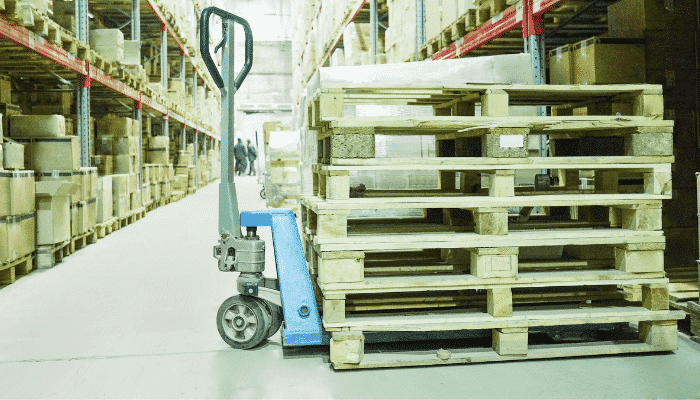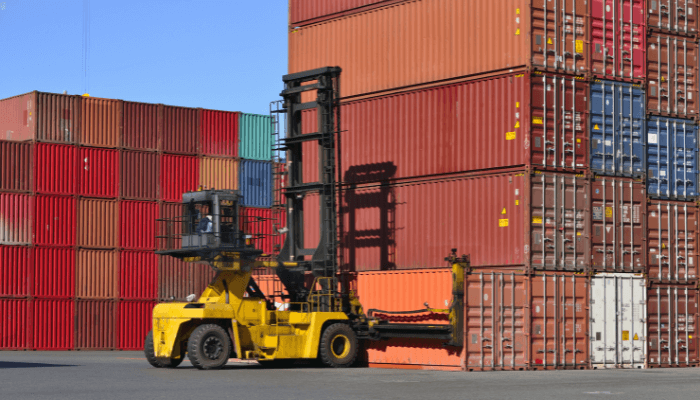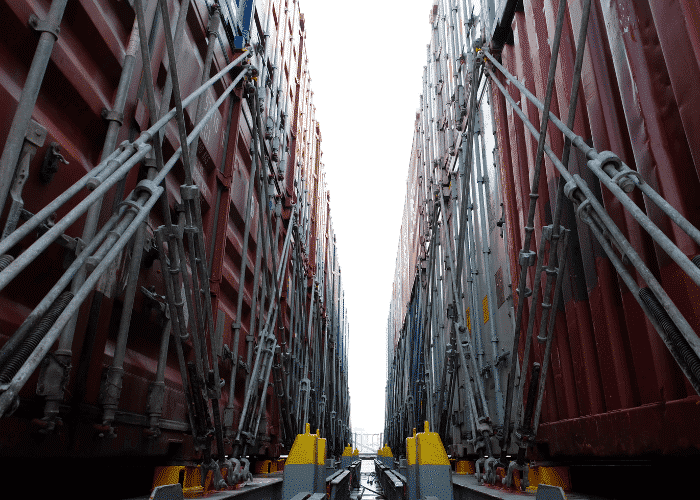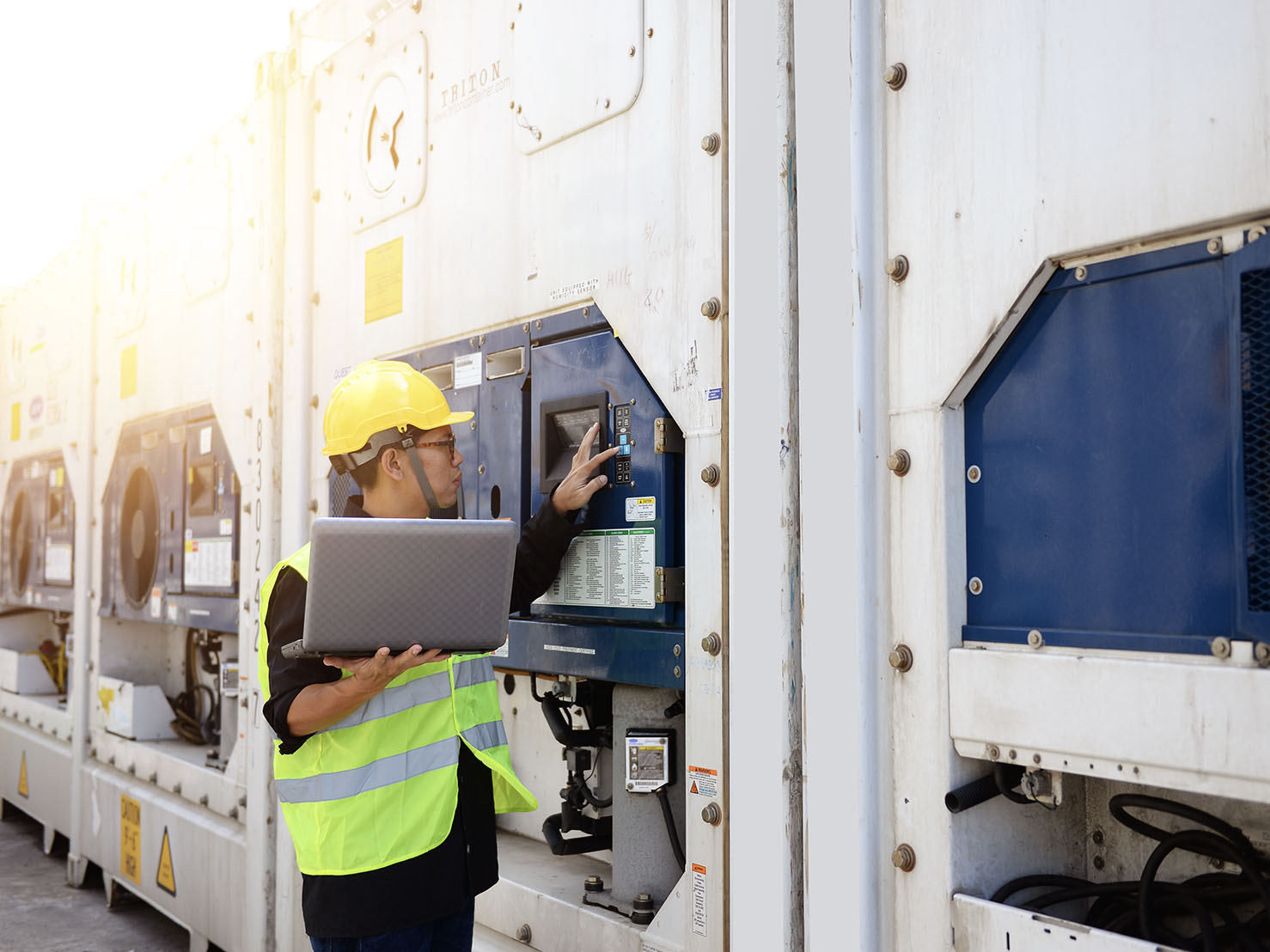Cargo Handler – Manual (1 years diploma)
Cargo Handler – Manual click here
Brief Job Description: The individual performs manual cargo handling activities
such as stevedoring, mooring and signalling the vessel and crane operators at
ports. S/He is responsible for individual performance as well as coordinating and
organising the team to achieve the defined task at hand
Qualifications Pack for Cargo handler – manual
Options
Option 1: Vessel deck operations
Option 1.1: Perform basic navigation
This unit is about performing deck operations involving positioning of vessels,
usage of flags and signs, and basic navigation
Option 1.2: Perform mooring and rope work in vessel
This unit is about undertaking mooring and rope work in the vessel
Option 2: Customs clearance
This unit is about performing post custom inspection requirements such as
packing, scanning, loading and transport arrangement, etc.

Personal Attributes:
The job holder should be medically and physically fit for manual cargo handling.
S/he should have problem solving skills to anticipate the task and prepare
accordingly. S/he should be observant, diligent and follow instructions to
complete work in a timely and effective manner
Description
Core Skills/Generic
Skills
Core Skills or Generic Skills are a group of skills that are key to learning and
working in today’s world. These skills are typically needed in any work
environment. In the context of the NOS, these include communication related
skills that are applicable to most job roles.
Function
Function is an activity necessary for achieving the key purpose of the sector,
occupation, or area of work, which can be carried out by a person or a group
of persons. Functions are identified through functional analysis and form the
basis of NOS.
Job role Job role defines a unique set of functions that together form a unique
employment opportunity in an organization.
Knowledge and
Understanding
Knowledge and Understanding are statements which together specify the
technical, generic, professional and organizational specific knowledge that an
individual needs in order to perform to the required standard.
National Occupational
Standards (NOS) NOS are Occupational Standards which apply uniquely in the Indian context
Electives
Electives are NOS/set of NOS that are identified by the sector as contributive
to specialization in a job role. There may be multiple electives within a QP for
each specialized job role. Trainees must select atleast one elective for the
successful completion of a QP with Electives
Options
Options are NOS/set of NOS that are identified by the sector as additional
skills. there may be multiple options within a QP. It is not mandatory to select
any of the options to complete a QP with Options.
Unit Code Unit code is a unique identifier for an Occupational Standard, which is
denoted by an ‘N’
Unit Title Unit title gives a clear overall statement about what the incumbent should be
able to do.
Occupation Occupation is a set of job roles, which perform similar/related set of functions
in an industry.
Organisational Context
Organisational Context includes the way the organization is structured and
how it operates, including the extent of operative knowledge managers have
of their relevant areas of responsibility.
Performance Criteria Performance Criteria are statements that together specify the standard of
performance required when carrying out a task.
Qualifications
Pack(QP)
Qualifications Pack comprises the set of NOS, together with the educational,
training and other criteria required to perform a job role. A Qualifications
Pack is assigned a unique qualification pack code.
Qualifications Pack
Code
Qualifications Pack Code is a unique reference code that identifies a
qualifications pack.
Scope Scope is the set of statements specifying the range of variables that an
individual may have to deal with in carrying out the function which have a
critical impact on the quality of performance required.
Sector
Sector is a conglomeration of different business operations having similar
businesses and interests. It may also be defined as a distinct subset of the
economy whose components share similar characteristics and interests.
Sub-Sector Sub-sector is derived from a further breakdown based on the characteristics
and interests of its components.
Sub-functions Sub-functions are sub-activities essential to fulfil the achieving the objectives
of the function.

Technical Knowledge Technical Knowledge is the specific knowledge needed to accomplish specific
designated responsibilities.
Description
CFS Container Freight Station
ERP Enterprise Resource Planning
EXIM Export Import
ETA Estimated Time of Arrival
GPS Global Positioning System
HR Human Resources
ICD Inland Container Depot
MHE Material Handling Equipment
NSQF National Skills Qualifications Framework
OH&S Occupational Health and Safety
OS Occupational Standards
OSHA Occupational Safety and Health Administration
PPE Personal Protective Equipment
QP Qualifications Pack
SOP Standard Operating Procedures
SWL Safe Working Load
VHF Very High Frequency
Collect cargo and vessel details and coordinate for smooth cargo movement
Description This unit is about reviewing and interpretting orders and vessel information as well
as coordinating within the team to ensure smooth cargo movement
Scope This unit/task covers the following:
• Plan for cargo movement
• Manual movement of cargo
• Prepare for mooring
• Prepare for signalling
Range: Personal Protective Equipment (PPE), Standard Operating Procedures (SOP),
Very High Frequency (VHF) radio, ropes, computer, projector, worksheets,
stationery etc.
Performance Criteria(PC) w.r.t. the scope
Element Performance Criteria
Plan for cargo
movement
To be competent, the user/ individual must be able to:
PC1. attend shift meetings to obtain daily task schedule
PC2. collect information on nature and volume of cargo and vessel berthing
details
PC3. collect appropriate equipment, devices and PPE for the activity
Manual movement of
cargo
To be competent, the user/ individual must be able to:
PC4. coordinate between gang members to jointly perform the task – moving of
cargo, rope work, etc.
PC5. identify cargo and load and unload cargo as per material handling SOP
PC6. perform safe rigging of containers and cargo using wires, locks, master-links,
winches, etc.
PC7. advise and support the team members during the activity as required
PC8. clean the vessel hold and the port cargo drop zones post discharge and
collect spillage
PC9. provide a daily activity report to the supervisor including damages and
injuries
Prepare for signalling To be competent, the user/ individual must be able to:
PC10. obtain daily task schedule from supervisor regarding signalling for vessel or
crane

PC11. obtain information on the vessel Estimated Time Of Arrival (ETA), berth
allocated, on-board cargo, size and type of vessel or type of crane, cargo
details and location for operations, etc.
PC12. obtain the necessary equipment – VHF radio, flags, PPEs, guide to flag codes, etc.
PC13. check that the equipment – VHF radio is functioning and that all flags are
available and perform a pre-operation checklist
PC14. ensure that the VHF frequency between the communicating instruments are
tuned and does not overlap with others
PC15. wear the necessary PPEs
Prepare for mooring To be competent, the user/ individual must be able to:
PC16. obtain instructions regarding mooring activity and position along with
details of vessel arrival time, berth allocated, on-board cargo, size and type
of vessel
PC17. obtain the necessary equipment – VHF radio, slip ropes, rope tails, quick
release hooks, etc.
PC18. assemble with the mooring gang at the berth and check for availability and
fitness of different mooring equipment and ropes
PC19. obtain the mooring plan from supervisor and take charge of allocated
responsibility
PC20. check the area for any hazards and use the appropriate PPE
Knowledge and understanding (K)
A. Organizational
context (Knowledge of
the company /
organization
and its
processes)
The individual on the job needs to know and understand:
KA1. organizational procedures and SOPs for tasks at hand, documentation policy
and emergency responses
KA2. security and safety procedures to be followed
KA3. reporting structure of the organization for escalation of issues
KA4. risk and impact of not following defined procedures/work instructions
KA5. coding system followed to label cargo
B. Technical knowledge
The individual on the job needs to know and understand:
KB1. different type of vessels and their cargo layout
KB2. different type of cargo and containers and their handling procedures and
SOPs

KB3. use of various cargo handling equipment and devices
KB4. use of hand signals, rope, mooring lines, flags, VHF radios and other relevant
equipment
KB5. SOPs for assisting in bulk cargo excavation and hold cleaning
KB6. handling procedures for hazardous cargo
KB7. special characteristics and handling requirements of shipments, if any
Skills (S)
A. Core skills/
generic skills
Reading skills
The user/individual on the job needs to know how to read:
SA1. written instructions
SA2. shiping manifest, Bill of lading shipping bills and related documents
SA3. damage reports and checklists
Writing skills
The user/individual on the job needs to know how to write:
SA4. work-orders and instructions
SA5. checklist of activities, delays, , etc
SA6. daily reports
Oral communication (listening and speaking skills)
The user/individual on the job needs to know how to:
SA7. communicate with on ground staff and equipment handlers
SA8. communicate with supervisors
B. Professional
skills
Decision making
The user/individual on the job needs to know how to:
SB1. decide regarding sequence of acitvities to perform a task
SB2. decide on allocation of work within a team to complete a task
SB3. decide when to escalate issues
SB4. identify daamges to packages and containers while cargo handling
Plan and organize
The user/individual on the job needs to know how to:
SB5. plan and coordinate between teams to achieve joint goals.
SB6. maintain punctuality
SB7. respond to the request in a timely manner
SB8. prioritize and execute tasks based on checklist and priorty requirements
SB9. do a check of activity completion
Customer centricity
The user/individual on the job needs to know how to:
SB10. adhere to the assigned timelines
SB11. address the urgency regarding shipments and activities
Problem solving
The user/individual on the job needs to know how to:
SB12. anticipate additional activities to successfully complete a task
SB13. identify and take precautions against common causes for accidents, delays
and damages
SB14. co-ordinate within gang to solve a problem when any gang-member is stuck
Analytical thinking
The user/individual on the job needs to know how to:
SB15. assess the resource requirement for a particular task at hand
SB16. assess the position and rope requirement for a vessel to dock
Critical thinking
The user/individual on the job needs to know and understand how to:
SB17. identify the vessel position for safe docking
SB18. Handle cargo preventing damages, particularly for dangerous goods
Perform stevedoring activities
Description This unit is about conducting survey of containers pre and post stuffing and that of
cargo
Scope This unit/task covers the following:
• Load/unload goods from vessel
• Goods movement
Range: Personal Protective Equipment (PPE), Standard Operating Procedures (SOP),
Very High Frequency (VHF) radio, ropes, computer, projector, worksheets,
stationery etc.
Performance Criteria(PC) w.r.t. the scope
Element Performance Criteria
Load/Unload goods
from vessel
To be competent, the user/ individual must be able to:
PC1. identify the cargo to be loaded/unloaded, based on markings and labels
PC2. segregate hazardous cargo

PC3. identify damaged cargo and inform supervisor
PC4. ensure cargo is sorted and stacked in correct location as per safety norms and
site conditions
PC5. execute lashing/unlashing of cargo and container as per lashing plan
PC6. perform safe rigging of containers and cargo using wires, locks, master-links,
winches, etc.
PC7. block and lash the cargo on the port, vessel or transporter using wires, hooks,
etc.
PC8. assist MHE operator in collecting bulk cargo from vessel holds and port drop
zones and storage
PC9. observe loading equipment, structures and material for any defect during
operations and highlight the same to supervisor
PC10. clean the vessel hold and the port cargo drop zones post discharge and collect
spillage
Goods movement To be competent, the user/ individual must be able to:
PC11. identify the location to which the cargo must be moved
PC12. undertake manual movement of cargo to the identified location and stack it
as per plan
PC13. ensure no undue effects of moving cargo from one location to another
PC14. undertake adequate care while moving loose, liquid, and hazardous cargo
PC15. coordinate as per plan during team lifting activities
PC16. follow lane discipline for people and material movement
PC17. assist in homogenous loading of bulk cargo in the vessel holds
PC18. provide daily activity report to supervisor including cargo moved, spillages,
accidents, injuries etc.
PC19. identify damaged goods
Knowledge and understanding (K)
A. Organizational
context (Knowledge
of the
company /
organization
and its
processes)
The individual on the job needs to know and understand:
KA1. organizational procedures and SOPs for tasks at hand, documentation policy
and emergency responses
KA2. security and safety procedures to be followed
KA3. reporting structure of the organization for escalation of issues
KA4. risk and impact of not following defined procedures/work instructions
KA5. coding system followed to label cargo
B. Technical
knowledge
The individual on the job needs to know and understand:
KB1. different type of vessels and their cargo layout
KB2. various signage and markings on the port terminal and their compliance
KB3. different type of cargo and containers and their handling procedures and
SOPs
KB4. stuffing and de-stuffing norms and procedures with respect to different cargo
KB5. use and operation of various cargo handling equipment and devices
KB6. use of rope, mooring lines, flags, VHF radios and other relevant equipment
KB7. SOPs for assisting in bulk cargo excavation and hold cleaning
KB8. handling procedures for hazardous cargo
KB9. special characteristics and handling requirements of shipments, if any
KB10. basic operation of small Material Handling Equipment (MHEs) – excavators
and fork lifts
KB11. basics of making knots, lifting cargo, using manual equipment for cargo
handling
KB12. type of lashing and rigging equipment and their uses – twist-locks, pelican
hooks, turn handles, lashing bars, bridging clamps, etc.
Skills (S)
C. Core skills/
generic skills
Reading skills
The user/individual on the job needs to know how to read:
SA1. written instructions
SA2. cargo and container markings and labels
SA3. shiping manifest, Bill of lading shipping bills and related documents
SA4. damage reports and checklists
Writing skills
The user/individual on the job needs to know how to write:
SA5. work-orders and instructions
SA6. checklist of activities, delays, , etc
SA7. daily reports
Oral communication (listening and speaking skills)
The user/individual on the job needs to know how to:
SA8. communicate with on ground staff and equipment handlers
SA9. communicate with supervisors
D. Professional
skills
Decision making
The user/individual on the job needs to know how to:
SB1. decide regarding sequence of acitvities to perform a task
SB2. decide the safest way to lash and rig cargo and containers
SB3. identify if a cargo is imprperly marked or damaged
Plan and organize
The user/individual on the job needs to know how to:
SB4. plan and coordinate between gangs to achieve joint goals.
SB5. maintain punctuality
SB6. respond to the requests in a timely manner
SB7. prioritize and execute tasks based on checklist and priorty requirements
SB8. do a check of activity completion
Customer centricity
The user/individual on the job needs to know how to:
SB9. adhere to the assigned timelines
SB10. address the urgency regarding priority requests
Problem solving
The user/individual on the job needs to know how to:
SB11. identify obstacles in the material movement path
SB12. identify irregularities or deformities in the loading/unloading equipment
SB13. co-ordinate within gang to tackle on ground problems related to lifting,
moving and identification of cargo
Analytical thinking
The user/individual on the job needs to know how to:
SB14. assess the posssible equipment for a particular task at hand
SB15. assess if the rigging and hook are secured for cargo movement
Critical thinking
The user/individual on the job needs to know and understand how to:
SB16. handle cargo preventing damages, particularly for dangerous goods
Perform mooring activities
Description This unit is about performing mooring activties
Scope This unit/task covers the following:
• Perform mooring activities
• Perform unmooring activities
• Report to supervisor
Range: Personal Protective Equipment (PPE), Standard Operating Procedures (SOP),
Very High Frequency (VHF) radio, ropes, computer, projector, worksheets, stationery
etc.
Performance Criteria(PC) w.r.t. the scope
Element Performance Criteria
Perform mooring
activities
To be competent, the user/ individual must be able to:
PC1. set the communication channels to the right frequency
PC2. clear berth conditions for mooring/unmooring
PC3. position cranes and gantries/loaders correctly for positioning of vessel
PC4. communicate any safety concerns to the vessel before commencement of
operations
PC5. communicate with vessel using VHF and hand signals while the vessel is
docking
PC6. communicate using common hand signals to receive the heaving and mooring
lines
PC7. receive the heaving line form the mooring launch and make it fast to
applicable bollard/hook
PC8. ensure correct method for crossing mooring lines over and between another
vessel’s mooring line is followed
PC9. receive the head line, breast line (stern line) and other lines, and fix around
the bollard/hook
PC10. tie all forward and aft mooring lines to secure vessel
PC11. ensure careful heaving line return
PC12. coordinate between gang to jointly set up the formwork/ rope ladders for
movement of cargo and load/ unload from the vessel
Perform unmooring activities
To be competent, the user/ individual must be able to:
PC13. inform vessel crew before commencing unmooring
PC14. remove tie and execute slinging activities as per plan
PC15. ensure mooring lines are clear from the propeller and stand clear of the
remaining lines which are under tension
PC16. communicate to the vessel regarding go-ahead once mooring lines are disengaged
To be competent, the user/ individual must be able to:
PC17. report to supervisor at the end of the task
PC18. escalate any accidents, damages or issues to the supervisor
Knowledge and understanding (K)
A. Organizational
context
(Knowledge of the
company /
organization and
its processes)
The individual on the job needs to know and understand:
KA1. organizational procedures and SOPs for tasks at hand, documentation policy
and emergency responses
KA2. security and safety procedures to be followed
KA3. reporting structure of the organization for escalation of issues
KA4. risk and impact of not following defined procedures/work instructions
KA5. coding system followed to label cargo
B. Technical
knowledge
The individual on the job needs to know and understand:
KB1. different type of vessels and their cargo layout
KB2. various signage and markings on the port terminal and their compliance
KB3. different type of cargo and containers and their handling procedures and SOPs
KB4. use and operation of various cargo handling equipment and devices
KB5. use of rope, mooring lines, flags, VHF radios and other relevant equipment
KB6. mooring and unmooring process and the different types of equipment used
KB7. handling procedures for hazardous cargo
KB8. special characteristics and handling requirements of shipments, if any
KB9. basics of making knots, different mooring lines and their strength and uses
KB10. SOP for tying and un-tying different mooring lines
KB11. hand signals for communicating with vessel deck staff
Skills (S)
B. Core skills/
generic skills
Reading skills
The user/individual on the job needs to know how to read:
SA10. written instructions
SA11. shiping manifest, bill of lading shipping bills and related documents
SA12. damage reports and checklists
Writing skills
The user/individual on the job needs to know how to write:
SA13. work-orders and instructions
SA14. checklist of activities, delays, , etc
SA15. daily reports
Oral communication (listening and speaking skills)
The user/individual on the job needs to know how to:
SA16. communicate with on ground staff and vessel deck staff
SA17. communicate with supervisors
C. Professional skills Decision making
The user/individual on the job needs to know how to:
SB1. decide regarding sequence of acitvities to perform a task
SB2. decide on allocation of work within a team to complete a task
SB3. identify if the mooring line is stout or there is slack in it
Plan and organize
The user/individual on the job needs to know how to:
SB4. plan and coordinate between gangs to achieve joint goals.
SB5. maintain punctuality
SB6. respond to the requests in a timely manner
SB7. prioritize and execute tasks based on SOP
SB8. do a check of activity completion
Customer centricity
The user/individual on the job needs to know how to:
SB9. adhere to the assigned timelines
SB10. address the urgency regarding vessel docking and casting

Problem solving
The user/individual on the job needs to know how to:
SB11. anticipate the effort required to tie the mooring line considering
environmental factors and vessel speed
SB12. Identify common causes for accidents, delays and damages and take
necessary precautions
SB13. co-ordinate within gang to solve a problem when any gang-member is stuck
Analytical thinking
The user/individual on the job needs to know how to:
SB14. assess the resource requirement for a particular task at hand
SB15. assess the position and rope requirement for a vessel to dock
Critical thinking
The user/individual on the job needs to know and understand how to:
SB16. identify the vessel position for safe docking
SB17. check that mooring lines well-knotted stout and tension free
Perform signalman activities
Description This unit is about performing signaling activtites for vessel docking and cargo
movement by cranes
Scope This unit/task covers the following:
• Signal the vessel in and out of berth
• Signal crane operators for cargo movement
• Report to supervisor
Range: Personal Protective Equipment (PPE), Standard Operating Procedures (SOP),
Very High Frequency (VHF) radio, ropes, computer, projector, worksheets,
stationery etc.
Performance Criteria(PC) w.r.t. the scope
Element Performance Criteria
Signal the vessel in
and out of berth
To be competent, the user/ individual must be able to:
PC1. confirm berthing plan with the ship and yard planning supervisor and the
vessel operator
PC2. communicate with vessel using VHF radio, flags and hand signals to guide the
vessel for docking
PC3. communicate with the outgoing vessel regarding a go-ahead using flags once
mooring lines are dis-engaged
Signal crane
operators for cargo
movement
To be competent, the user/ individual must be able to:
PC4. obtain the material movement plan and route for cargo and container
movement from ship and yard planning supervisor
PC5. identify cargo movement area and people movement area and follow them
strictly
PC6. coordinate with rigger and crane operator to provide signal when cargo is
ready and special handling requirement if any
PC7. coordinate with crane operators and assist in moving the cargo VHF devices
and hand and flag signals
PC8. follow the material handling procedures as per SOP and signal the Material
Handling Equipment (MHE)/ crane operator
PC9. inform the crane / MHE operator on any issues based on observation of cargo
and environment
PC10. identify impending dangers and communicate to the crane operator regarding
the same
Report to supervisor To be competent, the user/ individual must be able to:
PC11. report to supervisor at the end of the task
PC12. escalate any accidents, damages or issues to the supervisor
A. Organizational
context
(Knowledge of the
company /
organization and
its processes)
The individual on the job needs to know and understand:
KA1. organizational procedures and SOPs for tasks at hand, documentation policy
and emergency responses
KA2. security and safety procedures to be followed
KA3. reporting structure of the organization for escalation of issues
KA4. risk and impact of not following defined procedures/work instructions
KA5. coding system followed to label cargo
B. Technical knowledge
The individual on the job needs to know and understand:
KB1. different type of vessels and their cargo layout
KB2. different type of cargo and containers and their handling procedures and SOPs
KB3. use of various cargo handling equipment and devices
KB4. use of rope, mooring lines, flags, VHF radios and other relevant equipment
KB5. SOPs for assisting in bulk cargo excavation and hold cleaning
KB6. handling procedures for hazardous cargo
KB7. special characteristics and handling requirements of shipments, if any
KB8. use of hand signals, flags VHF radio and devices and basic troubleshooting for
VHF devices
KB9. material and people movement areas and precautions to be taken while
moving cargo
Skills (S)
C. Core skills/ generic
skills
Reading skills
The user/individual on the job needs to know how to read:
SA1. written instructions
SA2. shiping manifest, bill of lading shipping bills and related documents
SA3. damage reports and checklists
Writing skills
The user/individual on the job needs to know how to write:
SA4. work-orders and instructions
SA5. checklist of activities, delays, , etc
SA6. daily reports
Oral communication (listening and speaking skills)
The user/individual on the job needs to know how to:
SA7. communicate with on ground staff, crane operators and vessel operators
SA8. communicate with supervisors
D. Professional skills Decision making
The user/individual on the job needs to know how to:
SB1. decide on the flag and hand signal to be used during the course of vessel
docking and crane movement
SB2. decide if there is an obstruction in the path
SB3. identify damages to packages and containers while cargo handling
Plan and organize
The user/individual on the job needs to know how to:
SB4. plan and coordinate between different teams to achieve joint goals.
SB5. maintain punctuality
SB6. respond to the request in a timely manner
SB7. prioritize and execute tasks based on checklist and priorty requirements
SB1. do a check of activity completion
Customer centricity
The user/individual on the job needs to know how to:
SB8. adhere to the assigned timelines
SB2. address the urgency regarding docking and cargo operations
Problem solving
The user/individual on the job needs to know how to:
SB9. anticipate obstructions and hazards in the identified path for cargo and inform
SB10. identify and take precautions against common causes for accidents, delays and
damages
Analytical thinking
The user/individual on the job needs to know how to:
SB11. assess if the speed and route is secured for vessel docking
SB12. assess if the path is secured for cargo movement and speed of movement is
optimal
Critical thinking
The user/individual on the job needs to know and understand how to:
SB13. identify the vessel position for safe and stable docking
SB14. Identify obstructions, rigging errors, hazards in cargo movement path
Maintain integrity and ethics in operation
Description This OS unit is about maintaining integrity, ensuring data security, and professional
and ethical practices
Scope This unit/task covers the following:
• Maintain integrity and ensure data security
• Professional and ethical practices
• Ensure regulatory compliance
Range: Standard Operating Procedures (SOP), computer, projector, worksheets,
stationery, etc.
Performance Criteria(PC) w.r.t. the Scope
Element Performance Criteria
Maintain integrity
ensuring data
security
To be competent, the user/ individual must be able to:
PC1. refrain from indulging in corrupt practices
PC2. avoid using company’s funds, property or resources for undertaking personal
activities
PC3. protect customer’s information and ensure it is not misused
PC4. protect data and information related to business or commercial decisions
Practise ethical and
professional
behaviour
To be competent, the user/ individual must be able to:
PC5. avoid acceptance of cash or kind from vendors for support or contract
negotiations
PC6. demonstrate and practice ethics in day-to-day processes and dealings with
customers and colleagues
PC7. avoid nepotism
PC8. consult supervisor or senior management when in situations that may require
differentiating between ethical and unethical
PC9. report promptly all violations of code of ethics
PC10. dress up and conduct in a professional manner
PC11. communicate with clients and stakeholders in a soft and polite manner
PC12. follow etiquettes in accordance to the place

Ensure regulatory
compliance
To be competent, the user/ individual must be able to:
PC13. check for regulatory documentation and compliances for the shop floor as per
information from the supervisor
PC14. perform activities considering the regulatory requirements
PC15. use PPEs in accordance to regulatory requirements
PC16. identify the different types of dangerous goods and handling methodologies
PC17. follow the SOP for handling of different types of dangerous goods
PC18. consult supervisor or senior management when in situations that may require
differentiating between ethical and unethical
PC19. promptly report promptly all regulatory violations
Knowledge and understanding (K)
A. Organizational
context
(Knowledge of the
company /
organization and
its processes)
The user/individual on the job needs to know and understand:
KA1. company’s policies on use of language
KA2. company’s Human Resources policies
KA3. company’s code of ethics
KA4. company’s whistle blower policy
KA5. company’s rules related to sexual harassment
KA6. company’s reporting structure
KA7. company’s documentation policy
B. Technical knowledge
The user/individual on the job needs to know and understand:
KB1. principles of code of ethics and business ethics
KB2. various regulatory requirements
KB3. documentary compliance for various regulations
KB4. different dangerous shipment
KB5. regulations w.r.t dangerous shipment
Skills (S)
A. Core skills/
generic skills
Reading Skills
The individual on the job needs to know how to read:
SA1. company policy documents and work related documents
SA2. emails and written instructions
Writing Skills
The individual on the job needs to know how to fill:
SA3. documentation pertaining to ethics and regulatory requirement
Oral Communication (Listening and Speaking skills)
The individual on the job needs to know how to communicate with:
SA4. team members to work efficiently
SA5. peers and subordinates about information security and building trust
B. Professional skills
Decision making
The individual on the job needs to know how to:
SB1. identify a shipment as dangerous goods
SB2. assess if the situation needs to be reported regarding regulations
Plan and Organize
The individual on the job needs to know how to:
SB3. plan and organise actions as per company’s guidelines
Customer centricity
The individual on the job needs to know how to:
SB4. prevent company and customer information leakage
Problem solving
The individual on the job needs to know how to:
SB5. advisee colleagues regarding sensitive issues pertaining to conduct and
regulations
Analytical Thinking
The individual on the job needs to know how to:
SB6. provide professional services diligently and with integrity
Critical Thinking
The individual on the job needs to know how to:
SB7. avoid defaming company’s name by indulging into pilferage or fiddling with
quality or quantity of shipment
SB8. be fair and reasonable in profession and disclose conflict of interests
Follow health, safety and security procedures
Description This OS unit is about ensuring compliance with health, safety and security procedures
at the workplace
Scope This unit/task covers the following:
• Follow health, safety and security procedures
• Ensure compliance to health, safety and security
Range: Standard Operating Procedures (SOP), computer, projector, worksheets,
stationery, etc.
Performance Criteria(PC) w.r.t. the Scope
Element Performance Criteria
Follow health, safety
and security
procedures

To be competent, the user/ individual must be able to:
PC1. make note of all safety processes in different location (cargo loading area,
ramp operation area, etc.) with reference to area of operation
PC2. wear all Personal Protective Equipment (PPE) such as goggles, ear plugs,
helmet, mask, shoes, etc. as applicable in the cargo movement area
PC3. follow standard driving practice to ensure safety of life and material
PC4. follow organizational protocol to deploy action in case of signs of any
emergency situation or accident or breach of safety
PC5. undertake periodical preventive health check ups
PC6. follow necessary SOP and precautions while handling dangerous and
hazardous goods
PC7. follow security procedures like green gate in port, customs area, factory
security, etc.
PC8. comply with data safety regulations of the organisation
PC9. follow standard safety procedures while handling hazardous / fragile cargo
and walk only on the designated pathway
Ensure compliance to
health, safety and
security
To be competent, the user/ individual must be able to:
PC10. recognise unsafe conditions and safety practices at the workplace and report
it to concerned authority
PC11. inspect the activity area and equipment for appropriate and safe condition
PC12. check if stacking is done at defined height and is not on the walk way
PC13. check if walk way is free from grease/ oil
PC14. check if emergency fire alarms, water sprinklers and smoke detectors are
installed at all places
PC15. participate in fire drills
PC16. check if standard material handling procedure are being followed
PC17. check if hold ladders, platforms and hand rails to be in a sound and safe
condition
PC18. check if all the safety and security related tags, labels and signage are placed
in the cargo
PC19. check if loading instrument is certified and operational
PC20. implement 5S at workplace
PC21. check if cargo has passed security checks and report in case of any violation
Knowledge and understanding (K)
A. Organizational
context
(Knowledge of the
company /
organization and
its processes)
The individual on the job needs to know and understand:
KA1. health, safety and security policies and procedures
KA2. special instructions for hazardous cargo handling
KA3. defined standard operating procedures
KA4. risk and impact of not following defined procedures/work instructions with
reference to health, safety and security operations
KA5. escalation matrix for reporting identified problem
B. Technical
knowledge
The individual on the job needs to know and understand:
KB1. basics of Occupational Safety and Health Administration (OSHA)
KB2. 5S implementation and practice
KB3. necessary security procedures for airport, customs area, etc.
KB4. tools and equipment for material handling
KB5. standard material handling procedures while handling cargo
KB6. safety and security signage and their functions
KB7. different security tags, labels and signage
KB8. handling procedure for hazardous / fragile cargo
KB9. security procedures for dangerous / hazardous shipment
KB10. different PPE, their usage and purpose
KB11. safe driving techniques
Skills (S)
A. Core skills/
generic skills
Reading skills
The user/individual on the job needs to know how to read:
SA1. SOPs and safety precautions for different ground operations and handling
cargo
SA2. different documents related to security and movement of cargo
Writing skills
The user/individual on the job needs to know how to:
SA3. fill forms related to health, safety and security procedures
Oral communication (listening and speaking skills)
The user/individual on the job needs to know how to:
SA4. communicate clearly with colleagues regarding safety procedures
SA5. share experience and guide peers
B. Professional skills Decision making
The user/individual on the job needs to know how to:
SB1. decide how to avoid any damage / accident to personal health / cargo
handled, whenever required
SB2. act objectively, rather than impulsively or emotionally when faced with
difficult/stressful or emotional situations
Plan and organize
The user/individual on the job needs to know how to:
SB3. plan clearance of cargo in manner that it does hamper the safety of the cargo
and the loader/unloader
SB4. prioritize and execute tasks within the schedule time limits
SB5. plan and drive based on traffic and road condition using radio links/navigation
aids wherever available
Customer centricity
The user/individual on the job needs to know how to:
SB6. ensure safe and secure movement of shipments, cargos etc.
Problem solving
The user/individual on the job needs to know how to:
SB7. identify any threats on personal health, safety, security, etc. and take
appropriate actions
SB8. identify risks at the workplace and address them
Analytical thinking
The user/individual on the job needs to know how to:
SB9. analyse past mistakes and address them to avoid mishap in the future
Critical thinking
The user/individual on the job needs to know how to:
SB10. check that right safety measures and procedures are in place
Perform basic navigation
Description This unit is about performing basic navigation
Scope This unit/task covers the following:
• Identify vessel types, routes and locations
• Carry out watch keeping activity
Range : Personal Protective Equipment (PPEs), Standard Operating Procedures (SOPs)
and manuals, vessel models, various simulations for deck and engine operations,
cargo operations, vessel navigation, different equipment for deck and engine, model
cargo, etc.
Performance Criteria(PC) w.r.t. the scope
Element Performance Criteria
Identify vessel types,
routes and locations
To be competent, the user/individual on the job must be able to:
PC1. identify name of other vessels and type based on the call signs and flags
PC2. locate the position using latitude and longitude on the map and globe
PC3. identify different geographies and location, major navigation river routes on
the map
Carry out watch
keeping activity
To be competent, the user/individual on the job must be able to:
PC4. takeover watchkeeping from incumbent and understand the status report
PC5. execute orders stated by superiors using various nautical terms
PC6. maintain lookout and general surveillance of the vessel
PC7. watch for changes in environment weather conditions, obstacles in course and
possible collisions
PC8. document and record bridge activity, observations and communicate
PC9. handover the required details to the reliever
Knowledge and understanding (K)
A. Organizational
context
(Knowledge of the
company /
organization and
its processes)
The individual on the job needs to know and understand:
KA1. organizational procedures and SOPs for tasks at hand, documentation policy
and emergency responses
KA2. security and safety procedures to be followed
KA3. reporting structure of the organization for escalation of issues
KA4. risk and impact of not following defined procedures/work instructions
KA5. coding system followed to label cargo
B. Technical
knowledge
The individual on the job needs to know and understand:
KA6. various nautical terms related to navigation – hulls, shipside, engine room, etc.
KA7. various parts and components of the ship
KA8. map reading and identification of location in the globe
KA9. different type of vessels and their functions and cargo carried and cargo
handling requirements
KA10. various flag signals, sound signals, modes of communication and related norms
KA11. navigational charts and pressure and temperature measuring devices –
barometer, thermometer
KA12. various types of PPEs and their usage
Skills (S)
C. Core skills/
generic skills
Reading skills
The user/individual on the job needs to know how to read:
SA1. written instructions
SA2. shiping manifest, Bill of lading shipping bills and related documents
SA3. messages sent over internal communication systems
Writing skills
The user/individual on the job needs to know how to write:
SA4. work-orders and instructions
SA5. checklist of activities, delays, , etc
SA6. daily reports
Oral communication (listening and speaking skills)
The user/individual on the job needs to know how to:
SA7. communicate with vessel operators and mooring executive and signal man
SA8. communicate with supervisors
D. Professional skills Decision making
The user/individual on the job needs to know how to:
SB1. decide regarding sequence of acitvities to perform a task
SB2. decide on allocation of work within a team to complete a task
SB3. Identify obstructions and inform the deck
Plan and organize
The user/individual on the job needs to know how to:
SB4. plan and coordinate to perform the task at hand.
SB5. maintain punctuality
SB6. respond to the requests and communications in a timely manner
SB7. make checks on completion of activties
SB8. be a team player and achieve joint goals
Customer centricity
The user/individual on the job needs to know how to:
SB9. adhere to the assigned timelines
SB10. address the urgency regarding navigation and course correction
Problem solving
The user/individual on the job needs to know how to:
SB11. identify trends/common causes or errors in navigation, mooring and docking
and take precautions
SB12. estimate the effort and distance required to send ashore the mooring lines
Analytical thinking
The user/individual on the job needs to know how to:
SB13. assess the route for safe movement of the vessel
SB14. assess the position and rope requirement for a vessel to dock
Critical thinking
The user/individual on the job needs to know and understand how to:
SB15. identify the vessel route for safe manuevering and safe docking
SB16. Identify the mooring requirement for safe docking
SB17. check that the lines are rigged and secured







